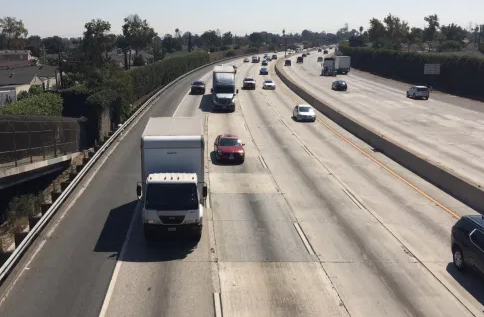Today, Metro delivered a presentation that revealed a few outlines of a new version of the agency's plan to demolish hundreds of homes to widen the 605 and 5 Freeway in southeast L.A. County.
Metro's 605 Freeway Corridor Improvement Project would spend billions of dollars to widen about 15 miles of the 605, plus other intersecting freeways. The 605CIP would widen about three miles of the 5 Freeway through the cities of Downey and Santa Fe Springs. Last August, Metro announced that the 605CIP would impact more than 1,200 properties – including demolishing more than 200 homes in the city of Downey. When Metro's "drastically" increased demolition totals were announced, numerous parties weighed in against the proposal. In October, the Metro board passed a motion delaying the project, while directing staff to come up with less destructive alternatives.
Today, at the Gateway Cities Council of Governments' (GCCOG) 91/605/405 Freeways Technical Advisory Committee (605TAC) meeting, was Metro's first public presentation of a less harmful alternative plan for the 605CIP.
Metro's presentation (starting on page 30) notes that along the 5 Freeway "ROW [right-of-way] impacts" would be reduced by "up to 34 percent."
Metro Project Manager Isidro Pánuco quantified those figures, stating that "in the late summer" Metro "had identified up to 259 parcel impacts in the city of Downey." Pánuco then broke down the new proposed alternative as two potential alternatives, each of which would entail demolitions on only one side of the 5 Freeway. As shown in a 2020 presentation by I-5 Consortium Cities Joint Powers Authority (I-5 JPA) Executive Director Yvette Kirrin, this means that Downey can choose between either impacting Dennis the Menace Park or Unsworth Elementary School.
Widening only west of the 5, Pánuco stated, would mean that Metro was "able to minimize impacts by up to 77 parcels for a total of 182 impacted residents."
Widening only east of the 5, Pánuco said, would mean that Metro was "able to reduce those impacts by 82, for approximately 156 impacts."
Though he then stressed that these numbers "are all tentative and preliminary."
Without more detail, it is impossible to reconcile Pánuco's new numbers with earlier Metro announcements. Each time Metro announces 605CIP right-of-way impact totals, the agency uses different breakdowns - so the comparisons are apples to oranges. No earlier figures separated the east and west sides of the 5. Metro's August figures are by city and do not specify which parcels are along the 5 vs. the 605 (and although Metro provided totals, the agency refused to provide lists or maps showing which parcels were part of the totals). Today, Pánuco mentioned impacts to "residents" seemingly interchangeably with "parcels," which appears to be incorrect. At least as of last year, Metro had targeted some Downey parcels that are apartment buildings with scores of residents; other parcels are single-family homes housing families.
In August, Metro had announced between 242 and 257 full acquisitions in the city of Downey. Pánuco's reported reductions are not from that previously announced baseline figure, but are apparently from new unpublished figures: 259 total parcel demolitions west of the 5, or 238 parcels east of the 5.
Today's demolition numbers - still totaling between 156 and 182 parcels (the vast majority of which are homes) impacted - remain drastically increased compared to Metro's 2014 605CIP plans. The 2014 plans showcased three alternatives, the worst of which showed 102 residential property impacts along the 5 Freeway. Pánuco referred to this plan today, stating that the new alternative "augmented" this earlier study.
Pánuco announced that Metro's new proposal would save space by narrowing the median. He shared a new proposed cross-section for 5 Freeway.
Today was the first time that Metro has publicly shared any aspect of this new 605CIP alternative; the proposal remains very sparse on details.
Though it had not been shared publicly, Pánuco stressed that it had been shared with the cities of Downey and Santa Fe Springs, as well as the Gateway COG, and I-5 JPA. TAC representatives from those cities expressed support for the new proposed alternative.
Santa Fe Springs Director of Public Works City Engineer Noe Negrete announced that he had gone over the new design "property by property" resulting in a "30 percent decrease" in parcel impacts. A thirty percent reduction from the 2020 totals would mean that Santa Fe Springs still sees between 29 and 37 demolitions, nearly all homes. Negrete stated that "we really hit our goal here" and asserted that freeway widening was needed to avoid "congestion on our local roads," as freeway congestion was already causing drivers to cut through the city, causing "damage... to local roads." This, of course, flies in the face of induced travel. Namely, widening the 5 Freeway will result in what Negrete says he wants to avoid: more car travel, more congestion, and more damaged roads. He did suggest that putting the proposal out for public input could mean "further reductions on the right-of-way."
Downey Deputy Director of Public Works Ed Norris acknowledged that "it's beneficial absolutely... if we... minimize the right-of-way take." He then seemed to argue that more demolitions would be good for Downey, "while [immediately adjacent to the I-5 Freeway] residents may benefit [from reduced right-of-way takes], other residents throughout the city are going to be impacted by the congestion, the cut-through traffic through the residential neighborhoods."
The TAC voted unanimously to support the reduced demolitions alternative being part of Metro's environmental studies.
Tomorrow (Wednesday) at 5 p.m., Metro is giving a presentation (with the same slide show at today's TAC meeting) to the GCCOG 605 Freeway Corridor Cities Committee, which is being requested to support the new alternative. The Zoom meeting is open to the public and will include time for public comment. Details can be found in the agenda packet.
Per Pánuco, the 605CIP item will return to the Metro board in a "February and April time frame."







